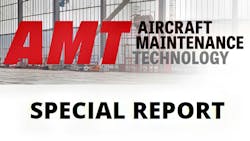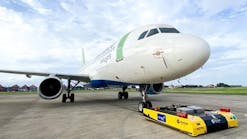The Federal Reserve is anticipated to make several cuts to interest rates this year, following projections made at the end of 2023.
When exactly these rate changes may occur is unclear. Some are anticipating cuts could come as early as spring, while the Fed has signaled there’s no clear path towards the cuts, as of yet.
Although rate changes will have wide-reaching impacts on areas such as mortgages, borrowing costs and spending, it’s anticipated to have a negligible impact on the MRO industry, said Jonathan Berger, Managing Director, Alton Aviation Consultancy.
“MRO demand is primarily driven by fleet size and aircraft utilization with the maintenance intervals defined by the OEM and regulatory requirements. Fluctuations in interest rates will have very limited impact,” Berger told AMT.
Instead, Berger said that the primary drivers and challenges that significantly influence the operational and financial aspects of the MRO industry are:
- Inflation
- Currency exchange rates (for non-US dollar-based economies)
- Material cost, availability and supply chain efficiency
- Labor cost, availability and productivity
With the MRO industry’s demand and operational challenges being more directly influenced by the industry-specific factors highlighted by Berger, it’s important to examine the strengths and weakness of those areas as the industry advances into 2024.
Fleet Size
Oliver Wyman, in conjunction with the Aeronautical Repair Station Association (ARSA), projects in their Global Fleet and MRO Market Forecast 2023-2033 that the worldwide commercial fleet will expand 33% to over 36,000 aircraft by 2033 — a compound annual growth rate of 2.9%. Today it's estimated the fleet numbers almost 27,400, which is just short of its size in January 2020 before the COVID-19 Pandemic.
Speaking at EAA AirVenture last year on their Pilot/Technician Outlook, Boeing forecasts demand for nearly 42,600 aircraft through 2042. The forecast shows the local fleet nearly doubling to 48,600 jets, expanding at a rate of 3.5% per year over the next 20 years. Approximately half of passenger jets will be replaced or replace other models, improving the global fleet's fuel efficiency and sustainability.
Labor
Severe shortfalls in the ranks of commercial airline pilots and aircraft mechanics are projected by both Oliver Wyman and Boeing.
Oliver Wyman’s analysis showed supply gaps amounted to 18% of the total pilot workforce in 2023 and 14% of aviation mechanics. The outlook shows those deficits growing or at least lingering through 2033. The gap between the number of pilots needed and those available has already led to reductions in air travel service to less popular and more rural destinations, hitting regional airlines hardest.
While there were just enough technicians to handle the MRO workload on the North American fleet in 2022, Oliver Wyman’s suggested a shortfall of somewhere between 12,000 and 18,000 happened in 2023.
By 2027 — projected to be the worst year for the shortage — the bleakest scenario has the deficit at more than 48,000 aircraft maintenance workers, or a shortfall of about 27%. Oliver Wyman’s more likely scenario predicts a gap of almost 43,000, or more than 24%.
Driving the deficit is the fact that most aircraft mechanics today are over 40 years old, with the percentage between those age 18 and 30 ranking only in the single digits.
Boeing said in the US, over 30% of aviation technicians will be at or near retirement in the next 10 years and over 25% of the commercial pilot workforce will reach mandatory retirement age within the next decade. The challenge for North American airlines will continue to be inspiring, developing, and training the next generation to fill the gap left by retirements and attrition.
As such, the competition for talent has increased significantly. The contract renewals for airline mechanics have resulted in double-digit increases and Boeing forecasts the demand for new technicians will be 690,000, or just over 34,500 per year over the next 10 years.
Supply Chain
Supply chain woes have been an ongoing struggle for the industry since the onset of the COVID-19 Pandemic.
The industry faces hard-to-remedy supply chain snarls that have already led to longer lead times on parts — sometimes of more than a year, Oliver Wyman said. As the industry gradually recovered in 2021 and 2022, both production and maintenance were hindered by suppliers unable to fulfill orders and provide products or services in a timely manner.
Unsurprisingly, much of the supply chain breakdown has been related to insufficient numbers of workers.
Oliver Wyman notes that supplier capacity problems are only likely to multiply once Airbus and Boeing begin to implement their higher production goals in coming years, which would be difficult to meet even if supply chains were functioning well. Some of their biggest suppliers have already suggested the elevated production may be beyond what they and the rest of the supply chain can handle.
The tight supply of many of these crucial items has pushed prices and operating costs significantly higher, Oliver Wyman said. Price increases have touched everything from jet fuel and salaries to aircraft parts, putting pressure on airline earnings.
While the potential interest rate cuts by the Federal Reserve will have a positive impact on some of these aspects, it will be only a marginal benefit in the face of these large, looming crises the MRO and greater aviation industry will be confronting in 2024 and beyond.






